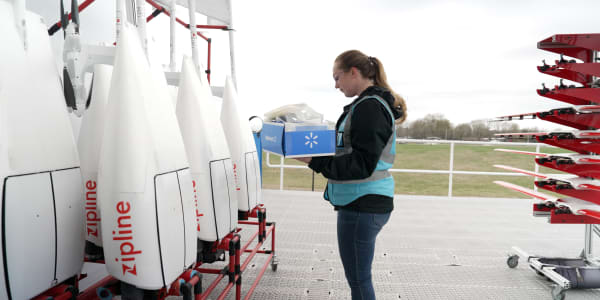
Amateur T-shirt designers with no money for manufacturing overhead have turned to Teespring (2016 CNBC Disruptor No. 21) to turn their clever ideas, smart logos and (sometimes corny) slogans into woven reality. Now four years old, Teespring boasts $58 million in funding, according to PitchBook, with contributions from heavyweights Khosla Ventures and Andreessen Horowitz. But now the San Francisco-based company that started with T-shirts is poised to begin selling other personalized, branded products created by designers worldwide.
"We call it the Amazon playbook," said co-founder and CEO Walker Williams, 27. "When you come to a Teespring store in the future, it won't feel like a T-shirt store. It'll feel like a natural, organic retail brand."
Now that Teespring has proved it can make life hassle-free for T-shirt designers, Williams said, the next step is to expand its line of products that will still be custom-made.
Teespring is in the on-demand business and resembles something of a Kickstarter for clothing. People or organizations with a design for a T-shirt upload it to the Teespring platform, adding text and tweaking their designs as necessary. Design costs usually run $9 per shirt, depending on the complexity as well as the shirt fabric. Then the designer sets a price for the T-shirt and the sale is launched on Teespring. But the sale goes live only when a certain number of shirts have been preordered by customers, at which point Teespring takes all the orders, sends the shirts to a manufacturing partner or its new $22 million manufacturing facility in Kentucky, ships them to the purchasers, and hands the T-shirt designer the difference between the sale and design prices of the T-shirt.
The upside for the sellers? A custom T-shirt design business with no money down and none of the usual hassles, like keeping an inventory of shirts that might not sell, or usual necessities, like paying for manufacturing and shipping. According to the company, 30 sellers sold more than $1 million on Teespring in 2015.
The upside for Teespring? With more than 17 million T-shirts shipped worldwide, the company that spent its earliest days in the high-profile accelerator Y Combinator will move beyond T-shirts, allowing designers to create custom merchandise that includes — well, Teespring isn't saying just yet.
"We're not announcing specifics of what's being released or the release schedule. But 2016 is the year that Teespring will be significantly expanding its product scope," Williams said. "When you walk into any top lifestyle-brand store, that's what Teespring is moving toward."
The company has already made strides in that direction. Last year it signed a partnership deal with the NFL, which now allows licensed apparel with team logos to be sold on Teespring's website. The eccentric, offbeat team T-shirts are designed by die-hard fans and experienced designers who have been selling on Teespring for a while. Other professional sports leagues are getting in on the action. In a call with CNBC, Williams specifically mentioned the NBA and said there is "some really exciting news coming."
Teespring's success is not without its hiccups. Prior to uploading a design to the online platform, Teespring asks would-be sellers to ensure that their designs don't infringe on any person's or organization's trademark rights. The company, which employs about 300 people full-time, uses an internal team to screen shirt designs, checking for problems and even removing T-shirt campaigns if it's warranted. But infringing designs do make it through from time to time. In one such situation in spring 2014, the Ohio State University sued Teespring for trademark infringement. That case has been settled, with no financial penalty for Teespring.
Still, sales continue to increase. Since launching in 2012, more than $200 million has been paid out to sellers worldwide, and 1 in 50 Americans purchased a Teespring shirt in 2015, according to numbers the company provided. That's a long way to have come from Brown University, where co-founders Williams and Evan Stites-Clayton, 26, came up with the idea for Teespring after they built a website to take orders for a T-shirt they were designing to commemorate the closing of a favorite nearby bar.
"There is a reason we started with apparel and now stayed in apparel for nearly four years: It's far better to be great at a few things than mediocre at many," Williams said. "We wanted to prove that we could be great at apparel. But we think of the product as a platform for entrepreneurs. Our goal is to allow someone to run a complete brand through Teespring."
— By Andrew Zaleski, special to CNBC.com









